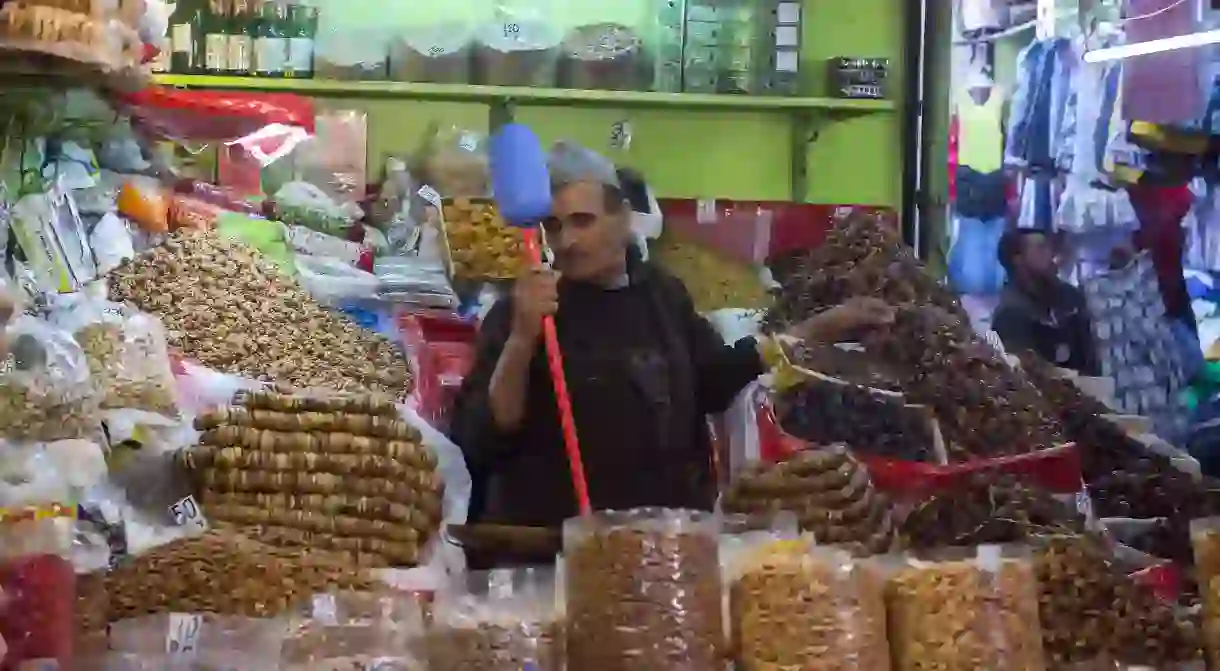An Essential Guide to Souk El Had

Souk El Had is the biggest souk (market) in Morocco’s city of Agadir. A popular place with locals and tourists alike, here’s everything you need to know before setting off for a shopping extravaganza.
The layout of Souk El Had
Bazaar

A large souk with around 6,000 stalls, Souk El Had is surprisingly easy to navigate when compared with many sprawling souks around Morocco. Twelve gates lead into the souk, and clear numbering makes it easy to arrange a meeting point and get your bearings. The crowds and chaos can, however, make some people feel overwhelmed; if that is the case, just walk in one direction until you come to an outer gate. You can then walk around the outer walls to get to where you want to be, or catch a taxi if you don’t want to walk. The stalls are grouped in a fairly well-organised manner, meaning that you can head straight to a particular gate if there are certain items you’re interested in buying. If you’re still a little wary of getting lost for an afternoon, consider booking a guided tour of the souk.
Things to buy in Souk El Had
Vendors sell an assortment of traditional Moroccan items, such as clothing, footwear, pottery, rugs, crafts, and musical instruments, as well as fresh fruits and vegetables, spices and everyday household goods. You’ll find almost anything you can think of here, from food and toiletries to home furnishings, electronics, jewellery and handicrafts.
Many fresh-produce and spice sellers can be found near gate five. Pottery, such as tagine pots, are also in this part of the souk, and if you’re looking for bags, leather goods and accessories, head to gate six.
Gates eight and nine are home to the majority of the tourist-orientated goods, such as souvenirs and knick-knacks. Gate nine is also known for its many jewellery stalls, with some authorised stores selling genuine gold and silver. Furniture is located near Gate 11, with many new and second-hand pieces available. Meanwhile, booksellers can also be found close to gate 11.

When to visit Souk El Had
The large market is open from 6am to 8.30pm every day of the week, except on Mondays, when the souk is closed for cleaning. Many stalls also close for a few hours on Friday afternoons so that sellers can attend afternoon prayers on the Islamic holy day. The souk’s name means the ‘Sunday Souk’, so it is little surprise that Sunday is the busiest day of the week. Otherwise, Tuesday, Wednesday, and Thursday are considered the best days for a visit as there are smaller crowds, and therefore a greater chance of being able to bargain for lower prices. Mornings are quieter, although not all stalls will be open for business at that time. Most sellers are in full swing by mid-afternoon, but this is also – of course – when the market is at its busiest.
Shopping tips
A good way to explore the market is to enter at gate five and browse the colourful fruits, vegetables, spices, olives and kitchenware before throwing yourself into the souk’s frenzy, finally exiting around gates eight, nine or 10. This is the reverse of the route most tourists take, who often enter the market at the top, close to the tourist shops, so you’ll be going against the flow.

Gate 10 has a particularly large number of unofficial guides lurking, waiting to make a quick buck from visitors. You really don’t need a guide, but if you do plan to hire one and prefer that a local accompany you through the mêlée, be sure to negotiate the price upfront but to pay at the end of the visit. Anywhere between 50 and 100 dirhams (£4-8) is a reasonable price for a two-hour souk tour. Also, keep in mind that they will likely lead you to stalls where they can make a decent commission, meaning that prices will be inflated to include that.
Unless prices are clearly marked, haggling is essential. Keep things lighthearted and fun while trying to reach an acceptable price for both parties. If you cannot agree on a final sum, you are under no obligation to buy. Don’t, however, begin haggling if you have no intention to buy. Keep in mind that accepting an offer of mint tea is generally seen as a sign that you will make a purchase.

While beach clothes are fine for sunbathing and swimming, cover up with more modest attire for a visit to the souk. Not only will this attract less attention, but it is also more respectful to local sensibilities.
Plus, ask before taking pictures of locals – it’s just good manners!
Places to take a break
There is a dedicated area of the souk for meals and drinks, where you can rest your weary feet and satisfy your appetite. Seafood, quick snacks like sandwiches and traditional Moroccan dishes are available. There’s a particularly charming café near gate six, where you can head up to the roof terrace for terrific views over the souk’s hustle and bustle. There are plenty of cafés, restaurants and snack shops outside the souk’s walls, too. Pop your head out of any of the gates and see if any local establishments catch your eye.
There’s no charge to enter the souk and look around, and you should plan to spend at least a couple of hours browsing and buying.
The privately built Agadir Medina is another great place for shopping in Agadir. While Agadir’s shopping destinations might not have quite the same character and atmosphere as the famous souks of, for example, Marrakech and Fez, you can still find an extensive selection of products, all while perfecting your haggling prowess.













